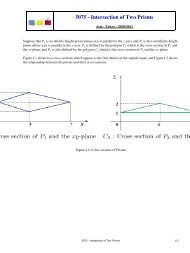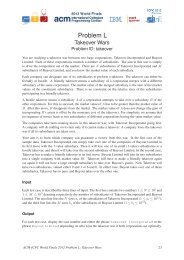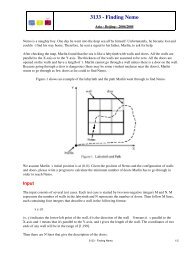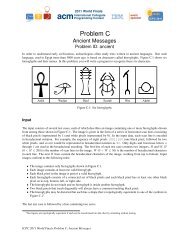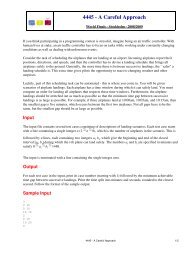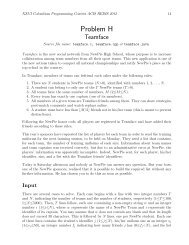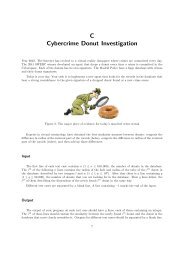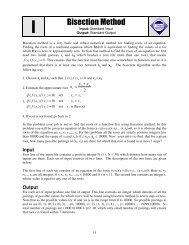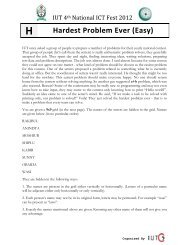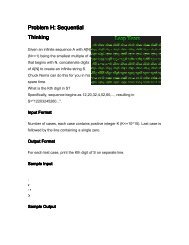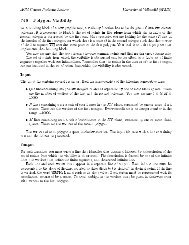PDF for J - UVa Online Judge
PDF for J - UVa Online Judge
PDF for J - UVa Online Judge
Create successful ePaper yourself
Turn your PDF publications into a flip-book with our unique Google optimized e-Paper software.
XXVI Colombian Programming Contest ACIS REDIS 2012 18Problem JLazy ProfessorSource file name: lazyprof.c, lazyprof.cpp or lazyprof.javaProfessor Yzal does not like to grade the exams of his students, so that he assigns this task tohis assistants. Final students’ grades are defined as weighted sums of the grades obtained inthe exams. But Professor Yzal does not define a priori the exam’s relative weights. Insteadof that, only when the assistants end their job (and all the students’ grades in each exam areknown) Professor Yzal decides the exam’s weights. He does it trying to be pleasant with thewhole class, so that the assigned weights should maximize the average final grade that the classobtains, and expecting that eventual complaints about his grading criteria will be as few aspossible. And finally, maybe rewarding harder exams, Yzal defines that the weight of everyparticular exam should lie within a specific range of values.This term is about to finish and you were hired to help Yzal with his lazy grading job. Yourtask is to write a program that, given the students’ grades and the reasonable range of weights<strong>for</strong> each exam, determines the maximum possible average according to the following rules:• Each exam must have a weight, defined as an integer number in the closed interval [0, 100],describing the assigned percentage.• The weight of an exam i must be in an integer closed interval [min i , max i ] that describesthe corresponding reasonable range previously defined by Yzal.• The sum of all exam weights must be 100.• The final grade of each student is a weighted sum calculated as the sum of his/her owngrades previously multiplied by the corresponding exam weight divided by 100.• The exam weights are so chosen that the average of the students’ final grades is maximized.InputThere are several cases to consider. Each test case is described as follows:• A line with two integer numbers S and N, separated by a blank, (1≤S≤100, 1≤N≤20),where S corresponds to the number of students and N corresponds to the number ofexams in the course.• Each one of the following S lines describes the grades of each student, containing N integernumbers c j1 , c j2 , . . . , c jN , separated by a blank, (0≤c ji ≤100 <strong>for</strong> each 1≤i≤N), where c jiindicates the grade obtained by the student j in the exam i (1≤j≤S, 1≤i≤N).• Each one of the following N lines describes the reasonable range of weights of each exam,containing two integer numbers min i , max i , separated by a blank (0≤min i ≤max i ≤100),where min i and max i represent the minimum and maximum weight that can be assignedto the exam i, respectively (1≤i≤N).
XXVI Colombian Programming Contest ACIS REDIS 2012 19You can suppose thatN∑min i ≤ 100, andN∑max i ≥ 100.i=1i=1The last test case is followed by a line containing two zeros.The input must be read from the file lazyprof.in.OutputFor each given case, output a single line with a number indicating the maximum possible averageof the students’ final grades if the weights are defined according to the rules. The answer shouldbe <strong>for</strong>matted and approximated to two decimal places. The floating point delimiter must be ‘.’(i.e., the dot). The rounding applies towards the nearest neighbor unless both neighbors areequidistant, in which case the result is rounded up (e.g., 78.312 is rounded to 78.31; 78.566 isrounded to 78.57; 78.345 is rounded to 78.35, etc.).The output must be written to standard output.Sample input1 100 1002 250 9070 500 1000 1002 250 9070 5030 7030 702 250 9070 5050 5050 502 273 5292 8120 5060 800 0Output <strong>for</strong> the sample input0.0070.0067.0065.0072.90



